Mechanisms of Weak Governance in Grasslands and Wetlands of South America
Abstract
:1. Introduction
The Umbrella Framework
“Analyses whose costs are taken into account in the economic calculus and what market measures can be considered as efficient outcomes. For example, what is the relation between efficiency and social acceptance? The market may produce multiple “efficient” outcomes and, thus, one must decide what kind of a state of a market is preferable.”[76] (pp. 21–26)
2. Methodology
2.1. Case Study Descriptions
2.2. Methodological Procedures
3. Results
3.1. Colombian Llanos
3.1.1. Online Survey in Colombia (Phase B)
3.1.2. GAF Colombia (Phase C)
3.2. Paraguayan Pantanal
3.2.1. Online Survey in Paraguay (Phase B)
3.2.2. GAF Paraguay (Phase C)
4. Discussion
4.1. Comparative Analysis: Governance in Colombia and Paraguay
4.1.1. Centralization
4.1.2. Role of Governments
4.1.3. Social Exclusion
- In-depth analysis of land-use using social representation studies that leverage our results when including the mechanisms of weak governance discussed;
- Central and local institutions in Colombia and Paraguay should formulate cross-cutting groups to manage natural resources, building capacity for inclusive forms of governance (principles and frameworks through decentralization of functions and power to locals);
- Civil society should implement projects focusing on need-based development for better management of natural resources as well as poverty alleviation and the reduction of socio-economic inequality.
4.2. Limitations
5. Conclusions
Author Contributions
Funding
Acknowledgments
Conflicts of Interest
Appendix A
| Colombia | Paraguay |
|---|---|
|
|
| |
|
|
| |
|
|
|
|
|
|
|
|
|
|
|
|
|
|
|
|
|
|
|
|
|
|
|
|
|
|
References
- Suttie, J.M.; Reynolds, S.G.; Batello, C. (Eds.) Grasslands of the World; FAO: Rome, Italy, 2005. [Google Scholar]
- Ridder, R.M. Global Forest Resources Assessment 2010: Options and Recommendations for a Global Remote Sensing Survey of Forests; FAO For. Resource Assessement Programme Working Paper 141; FAO: Rome, Italy, 2007. [Google Scholar]
- Conant, R.T. Challenges and Opportunities for Carbon Sequestration in Grassland Systems; FAO: Rome, Italy, 2010. [Google Scholar]
- Rippstein, G. Agroecología y Biodiversidad de las Sabanas en los Llanos Orientales de Colombia; Ciat: Cali, Colombia, 2001. [Google Scholar]
- Blydenstein, J. Tropical Savanna Vegetation of the Llanos of Colombia. Ecology 1967, 48, 1–15. [Google Scholar] [CrossRef]
- Swarts, F.A. The Pantanal of Brazil, Bolivia and Paraguay: Selected Discourses on the World’s Largest Remaining Wetland System; Paragon House: St. Paul, MN, USA, 2000. [Google Scholar]
- Guyra Paraguay. Informe de Deforestación Marzo 2017; Guyra Paraguay: Asuncion, Paraguay, 2017. [Google Scholar]
- Pollock, M.M.; Naiman, R.J.; Hanley, T.A. Plant species richness in riparian wetlands—A test of biodiversity theory. Ecology 1998, 79, 94–105. [Google Scholar]
- Mitsch, W.J.; Zhang, L.; Waletzko, E.; Bernal, B. Validation of the ecosystem services of created wetlands: Two decades of plant succession, nutrient retention, and carbon sequestration in experimental riverine marshes. Ecol. Eng. 2014, 72, 11–24. [Google Scholar] [CrossRef]
- Maltby, E.; Acreman, M.C. Ecosystem services of wetlands: Pathfinder for a new paradigm. Hydrol. Sci. J. 2011, 56, 1341–1359. [Google Scholar] [CrossRef]
- O’Mara, F.P. The role of grasslands in food security and climate change. Ann. Bot. 2012, 110, 1263–1270. [Google Scholar] [CrossRef] [Green Version]
- Mitsch, W.J.; Bernal, B.; Hernandez, M.E. Ecosystem services of wetlands. Int. J. Biodivers. Sci. Ecosyst. Serv. Manag. 2015, 11, 1–4. [Google Scholar] [CrossRef] [Green Version]
- Ishwaran, N.; Clüsener-Godt, M. Los Sitios UNESCO en Iberoamérica para Medio Ambiente y Cultura Como Escenarios del Desarrollo Sostenible. Hacia una Cultura de la Conservación de la Diversidad Biológica, Zaragoza, SEA, Conabio, Conanp, Conacyt, Inecol; Unesco-MAB, Ministerio de Medio Ambiente-Gobierno de España: Zaragoza, Spain, 2007. [Google Scholar]
- Salcedo, H.R.; Barrera, A.C. Sobre los procesos de enseñanza-aprendizaje en el legado de los cantos de trabajo del llano, patrimonio cultural inmaterial de la Orinoquia. Cultura Lenguaje Representación 2019, 21, 133–156. [Google Scholar] [CrossRef] [Green Version]
- Anderson, R.; Rockel, M. Economic Valuation of Wetlands: Discussion Paper n. 065; American Petroleum Institute: Washington, DC, USA, 1991. [Google Scholar]
- Barbier, E.B.; Acreman, M.; Knowler, D. Valoración Económica de los Humedales: Guía para Decisores y Planificadores; Gland: Oficina de la Convención de Ramsar: Cambridge, UK, 1997. [Google Scholar]
- Woodward, R.T.; Wui, Y.-S. The economic value of wetland services: A meta-analysis. Ecol. Econ. 2001, 37, 257–270. [Google Scholar] [CrossRef]
- Brander, L.M.; Florax, R.J.G.M.; Vermaat, J. The Empirics of Wetland Valuation: A Comprehensive Summary and a Meta-Analysis of the Literature. Environ. Resour. Econ. 2006, 33, 223–250. [Google Scholar] [CrossRef] [Green Version]
- Plummer, M.L. Assessing benefit transfer for the valuation of ecosystem services. Front. Ecol. Environ. 2009, 7, 38–45. [Google Scholar] [CrossRef] [Green Version]
- Heidenreich, B. What Are Global Temperate Grasslands Worth? A Case for Their Protection IUCN: Gland, Switzerland, 2009. [Google Scholar]
- Mereles, M.F. Los Humedales del Paraguay: Principales Tipos de Vegetación. In Los humedales de Paraguay; Salas, D.A., Mereles, M.F., Yanosky, A., Eds.; Comité Nacional de Humedales del Paraguay: Asunción, Paraguay, 2004; pp. 67–87. [Google Scholar]
- Folke, C. The Societal Value of Wetland Life-Support. Linking the Natural Environment and the Economy: Essays from the Eco-Eco Group; Springer: Dordrecht, The Netherlands, 1991; pp. 41–171. [Google Scholar]
- Adams, W.M. Indigenous use of wetlands and sustainable development in West Africa. Geogr. J. 1993, 159, 209–218. [Google Scholar] [CrossRef]
- Mejía, C.A.C. Palabra de agua: Relatos ancestrales muiscas para la recuperación ecológica del humedal Tibabuyes. InvestigiumIre Ciencias Sociales Humanas 2013, 4, 122–132. [Google Scholar]
- Mosquera, S.L.; Nieto, O.; Tapia, C. Humedales para la Gente: Visiones desde lo Local; Instituto de Investigación de Recursos Biológicos Alexander von Humboldt: Bogotá, Colombia, 2015; p. 98. [Google Scholar]
- Chaikumbung, M.; Doucouliagos, H.; Scarborough, H. Institutions, Culture, and Wetland Values. Ecol. Econ. 2019, 157, 195–204. [Google Scholar] [CrossRef] [Green Version]
- Ioris, A.A.R.; Irigaray, C.T.; Girard, P. Institutional responses to climate change: Opportunities and barriers for adaptation in the Pantanal and the Upper Paraguay River Basin. Clim. Chang. 2014, 127, 139–151. [Google Scholar] [CrossRef] [Green Version]
- Schulz, C.; Whitney, B.S.; Rossetto, O.C.; Neves, D.M.; Crabb, L.A.H.; Oliveira, E.C.; Lima, P.L.T.; Afzal, M.; Laing, A.; De Souza, L.C.; et al. Physical, ecological and human dimensions of environmental change in Brazil’s Pantanal wetland: Synthesis and research agenda. Sci. Total Environ. 2019, 687, 1011–1027. [Google Scholar] [CrossRef] [PubMed]
- Ioris, A.A.R. Rethinking Brazil’s Pantanal Wetland. J. Environ. Dev. 2013, 22, 239–260. [Google Scholar] [CrossRef]
- Peñuela, L. Sabana Inundable y Ganadería, Opción Productiva de Conservación en la Orinoquia; No. LC-0835; Fundación Natura: Bogota, Colombia, 2014. [Google Scholar]
- Soto, B.F.; Gómez, S. Dinámicas del Mercado de la Tierra en América Latina y el Caribe: Concentración y Extranjerización; FAO: Rome, Italy, 2012. [Google Scholar]
- Soto, B.F.; Gómez, S. (Eds.) Reflexiones sobre la Concentración y Extranjerización de la Tierra en América Latina y el Caribe; FAO: Rome, Italy, 2013. [Google Scholar]
- Rincón, S.; Flantua, S. Identifying Highly Biodiverse Savannas Based on the European Union Renewable Energy Directive (SuLu Map): Conceptual Background and Technical Guidance; WWF: Asuncion, Paraguay, 2014. [Google Scholar]
- World Wildlife Fund (WWF). Social, Economic and Environmental Analysis of Soybean and Meat Production in Paraguay; WWF: Asunción, Paraguay, 2016. [Google Scholar]
- Martínez-Alier, J. Los conflictos ecológico-distributivos y los indicadores de sustentabilidad. Revibec: Revista Red Iberoamericana Economía Ecológica 2004, 1, 21–30. [Google Scholar]
- Blaser, M. The Threat of the Yrmo: The Political Ontology of a Sustainable Hunting Program. Am. Anthr. 2009, 111, 10–20. [Google Scholar] [CrossRef]
- Acuña, R.M. The politics of extractive governance: Indigenous peoples and socio-environmental conflicts. Extr. Ind. Soc. 2015, 2, 85–92. [Google Scholar] [CrossRef]
- Guereña, A.; Villagra, V.L. Yvy Jára: Los Dueños de la Tierra en Paraguay; Oxfam: Asunción, Paraguay, 2016. [Google Scholar]
- Hincapié, S. Extractivismo, consultas populares y derechos políticos ¿el renacimiento de la democracia local en Colombia? Reflexión Política 2017, 19, 86–99. [Google Scholar] [CrossRef] [Green Version]
- Duarte, O.J. Desarrollo, Extractivismo Petrolero y Transformaciones Socioterritoriales en el Municipio de Aguazul, Casanare (Colombia) 1990–2015. Master’s Thesis, Universidad Nacional de Colombia, Sede Bogotá, Colombia, 2018. [Google Scholar]
- Eufemia, L.; Bonatti, M.; Sieber, S. Synthesis of Environmental Research Knowledge: The Case of Paraguayan Pantanal Tropical Wetlands. Sustain. Agric. Res. 2018, 7, 125–133. [Google Scholar] [CrossRef]
- Safford, T.G. The Political—Technical Divide and Collaborative Management in Brazil’s Taquari Basin. J. Environ. Dev. 2010, 19, 68–90. [Google Scholar] [CrossRef]
- Garcia, M.M.; Bodin, Ö. Participatory Water Basin Councils in Peru and Brazil: Expert discourses as means and barriers to inclusion. Glob. Environ. Chang. 2019, 55, 139–148. [Google Scholar] [CrossRef]
- Ardila Barbosa, W.Y. Impactos de la Industria Petrolera en el Medio Ambiente-Upstreamí. Ph.D. Thesis, Universidad Industrial de Santander, Escuela de Ingenieria de Petróleos, Bogota, Colombia, 2014. [Google Scholar]
- Vatn, A. An institutional analysis of payments for environmental services. Ecol. Econ. 2010, 69, 1245–1252. [Google Scholar] [CrossRef]
- Larson, A.M.; Soto, F. Decentralization of natural resource governance regimes. Annu. Rev. Environ. Resour. 2008, 33, 213–239. [Google Scholar] [CrossRef]
- Lockwood, M.; Davidson, J.; Curtis, A.; Stratford, E.; Griffith, R. Governance Principles for Natural Resource Management. Soc. Nat. Resour. 2010, 23, 986–1001. [Google Scholar] [CrossRef]
- Halsall, J.; Oberoi, R.; Cook, I.G.; Wankhade, P. Understanding community governance: A global perspective. Int. J. Asian Soc. Sci. 2013, 3, 1112–1127. [Google Scholar]
- Quintero López, M.; Fabio, A.; Arbeláez, A. Nature conservation on private land: Natural Reserves of Civil Society in Valle del Cauca. Apuntes Cenes 2016, 35, 17–48. [Google Scholar] [CrossRef] [Green Version]
- Blaser, M. Storytelling Globalization from the Chaco and Beyond; Duke University Press: Durham, NC, USA, 2010. [Google Scholar]
- Ansell, C.; Torfing, J. Handbook on Theories of Governance; Edward Elgar Publishing: Cheltenham, UK, 2016. [Google Scholar]
- De Castro, F. Gobernanza Ambiental en América Latina; Hogenboom, B., Baud, M., Eds.; Clacso: Buenos Aires, Argentina, 2015. [Google Scholar]
- Lamont, H. Environmental Governance: The Global Challenge; Island Press: Washington, DC, USA, 1996. [Google Scholar]
- Gudynas, E. Diez tesis urgentes sobre el nuevo extractivismo. Extractivismo Política Sociedad 2009, 187, 222–223. [Google Scholar]
- Acosta, A. Extractivismo y neoextractivismo: Dos caras de la misma maldición. Más Allá Desarrollo 2011, 1, 83–118. [Google Scholar]
- Olivos, Á.R. El concepto de bienes comunes en la obra de Elinor Ostrom. Ecología Política 2013, 45, 116–121. [Google Scholar]
- Zurbriggen, C. Governance a Latin America perspective. Policy Soc. 2014, 33, 345–360. [Google Scholar] [CrossRef] [Green Version]
- Palmer, D.; Fricska, S.; Wehrmann, B. Towards Improved Land Governance; Food and Agriculture Organization of the United Nations, United Nations Human Settlements Programme: Rome, Italy, 2009. [Google Scholar]
- Rudd, M.A. An institutional framework for designing and monitoring ecosystem-based fisheries management policy experiments. Ecol. Econ. 2004, 48, 109–124. [Google Scholar] [CrossRef] [Green Version]
- Ostrom, E. Understanding Institutional Diversity; Princeton University Press: Princeton, NJ, USA, 2005. [Google Scholar]
- Clement, F. Analysing decentralised natural resource governance: Proposition for a “politicised” institutional analysis and development framework. Policy Sci. 2010, 43, 129–156. [Google Scholar] [CrossRef]
- Clement, F.; Amezaga, J.M. Conceptualising context in institutional reforms of land and natural resource management: The case of Vietnam. Int. J. Commons 2013, 7, 140–163. [Google Scholar] [CrossRef]
- Nigussie, Z.; Tsunekawa, A.; Haregeweyn, N.; Adgo, E.; Cochrane, L.; Floquet, A.; Abele, S. Applying Ostrom’s institutional analysis and development framework to soil and water conservation activities in north-western Ethiopia. Land Use Policy 2018, 71, 1–10. [Google Scholar] [CrossRef]
- Ostrom, E.; Gardner, R.; Walker, J. Rules, Games, and Common-Pool Resources; University of Michigan Library: Ann Arbor, MI, USA, 1994. [Google Scholar]
- Ostrom, E. Institutional Rational Choice: An Assessment of the Institutional Analysis and Development Framework. In Theories of the Policy Process, 2nd ed.; Sabatier, P.A., Ed.; Westview Press: Cambridge, MA, USA, 2007; pp. 21–64. [Google Scholar]
- Ostrom, E. Background on the Institutional Analysis and Development Framework. Policy Stud. J. 2011, 39, 7–27. [Google Scholar] [CrossRef]
- Ostrom, E. Governing the Commons; Cambridge University Press (CUP): Cambridge, UK, 1990. [Google Scholar]
- Ostrom, E. Designing Complexity to Govern Complexity. In Property Rights and the Environment: Social and Ecological Issues; Munasinghe, M., Hanna, S., Eds.; The International Bank for Reconstruction and Development: Washington, DC, USA, 1995; pp. 33–45. [Google Scholar]
- Nickson, A. Where Is Local Government Going in Latin America? A Comparative Perspective; Swedish International Centre for Local Democracy Fuente: Stockholm, Sweden, 2016. [Google Scholar]
- Saunders, F.P. The promise of common pool resource theory and the reality of commons projects. Int. J. Commons 2014, 8, 636–656. [Google Scholar] [CrossRef]
- Hiram, Á.L. El gobierno de los bienes comunes: La evolución de las instituciones de acción colectiva. Región Sociedad 2002, 14, 263–269. [Google Scholar]
- Cyert, R.M.; March, J.G. A behavioral theory of the firm. Englewood Cliffs N. J. 1963, 2, 169–187. [Google Scholar]
- Herbert, S.A. Theories of bounded rationality. Decis. Org. 1972, 1, 161–176. [Google Scholar]
- Eaton, W.O. The Economic Institutions of Capitalism: Firms, Markets, Relational Contracting; Free Press: New York, NY, USA, 1985. [Google Scholar]
- Williamson, O.E. The Mechanisms of Governance; Oxford University Press: Oxford, UK, 1996. [Google Scholar]
- Petri, O. Principles of Institutional Economics–with Applications to Cooperative Enterprises; Working Papers 56; Departments of Economics, Helsinki University: Helsinki, Finland, 2009. [Google Scholar]
- Lee, A.J.; North, D.; Eggerttson, T. (Eds.) Empirical Studies in Institutional Change; Cambridge University Press: Cambridge, UK, 1996. [Google Scholar]
- North, D.C. Introduction to Understanding the Process of Economic Change; Princeton University Press: Princeton, NJ, USA, 2005. [Google Scholar]
- Hufty, M. Investigating Policy Processess: The Governance Analytical Framework (GAF). In Research for Sustainable Development: Foundations, Experiences, and Perspectives; Wiesmann, U., Huni, H., Eds.; North-South/Geographica: Bern, Switzerland, 2012; Volume 1, pp. 403–424. [Google Scholar]
- Biernacki, P.; Waldorf, D. Snowball Sampling: Problems and Techniques of Chain Referral Sampling. Sociol. Methods Res. 1981, 10, 141–163. [Google Scholar] [CrossRef]
- Iribarnegaray, M.A.; Seghezzo, L. Governance, Sustainability and Decision Making in Water and Sanitation Management Systems. Sustainability 2012, 4, 2922–2945. [Google Scholar] [CrossRef] [Green Version]
- Abe, J.; Brown, B.; Ajao, E.A.; Donkor, S. Local to regional polycentric levels of governance of the Guinea Current Large Marine Ecosystem. Environ. Dev. 2016, 17, 287–295. [Google Scholar] [CrossRef]
- Montoya, M.A.; Chauvet, M. Technical standards in nanotechnology as an instrument of subordinated governance: Mexico case study. J. Responsible Innov. 2016, 3, 1–34. [Google Scholar]
- Clifford, G. Thick Description: Toward an Interpretive Theory of Culture. The Interpretation of Cultures: Selected Essays; Basic: New York, NY, USA, 1973; pp. 3–30. [Google Scholar]
- Malinowski, B. Argonauts of the Western Pacific: An Account of Native Enterprise and Adventure in the Archipelagoes of Melanesian New Guinea [1922/1994]; Routledge: London, UK, 2013. [Google Scholar]
- Watts, M. Political Ecology. In A Companion to Economic Geography; Peck, J., Sheppard, E., Barnes, T., Eds.; Blackwell Publishing: Malden, MA, USA, 2000; pp. 257–274. [Google Scholar]
- Robbins, P. Political Ecology: A critical Introduction; John Wiley & Sons: Hoboken, NJ, USA, 2011; Volume 16. [Google Scholar]
- Kay, C. La transformación neoliberal del mundo rural: Procesos de concentración de la tierra y del capital y la intensificación de la precariedad del trabajo. Revista Latinoamericana Estudios Rurales 2016, 1, 1–26. [Google Scholar]
- Brand, U.; Dietz, K.; Lang, M. Neo-Extractivism in Latin America—One side of a new phase of global capitalist dynamics. Ciencia Política 2016, 11, 125–159. [Google Scholar] [CrossRef] [Green Version]
- Hare, D.; Forstchen, A.B.; Smith, C.A.; Decker, D.J. Developing Governance Principles for Public Natural Resources. Soc. Nat. Resour. 2017, 31, 382–388. [Google Scholar] [CrossRef]
- Vargas, J.G. Teoría de la acción colectiva, sociedad civil y los nuevos movimientos sociales en las nuevas formas de gobernabilidad en Latinoamérica. Espacio Abierto 2003, 12, 523–537. [Google Scholar]
- Eggertsson, T. Economic Behavior and Institutions; Cambridge University Press: Cambridge, UK, 1990. [Google Scholar]
- Barzel, Y. Economic Analysis of Property Rights; Cambridge University Press: Cambridge, UK, 1997. [Google Scholar]
- Stebek, E. Conceptual Foundations of Property Rights: Rethinking De Facto Rural Open Access to Common-Pool Resources in Ethiopia. Mizan Law Rev. 2011, 5, 1–40. [Google Scholar] [CrossRef]
- Shah, S.A. Corruption and Decentralized Public Governance; World Bank: Washington, DC, USA, 2006. [Google Scholar]
- Loury, G. A dynamic theory of racial income differences. Women Minor. Empl. Discrim. 1977, 153, 86–153. [Google Scholar]
- Putnam, R.D.; Leonardi, R.; Nanetti, R.Y. Making Democracy Work: Civic Traditions in Modern Italy; Princeton University Press: Princeton, NJ, USA, 1994. [Google Scholar]
- Smith, T.W. Factors Relating to Misanthropy in Contemporary American Society. Soc. Sci. Res. 1997, 26, 170–196. [Google Scholar] [CrossRef]
- Smith, M.H.; Beaulieu, L.J.; Seraphine, A. Social Capital, Place of Residence, and College Attendance1. Rural. Sociol. 2010, 60, 363–380. [Google Scholar] [CrossRef]
- Teachman, J.D.; Paasch, K.; Carver, K. Social Capital and Dropping Out of School Early. J. Marriage Fam. 1996, 58, 773. [Google Scholar] [CrossRef]
- Brehm, J.; Rahn, W. Individual-Level Evidence for the Causes and Consequences of Social Capital. Am. J. Pol. Sci. 1997, 41, 999–1023. [Google Scholar] [CrossRef] [Green Version]
- Manuel, C.C. Gobernanza y participación ciudadana en las políticas públicas frente al reto del desarrollo. Política Cultura 2008, 30, 9–37. [Google Scholar]
- Beall, J. Globalization and social exclusion in cities: Framing the debate with lessons from Africa and Asia. Environ. Urban. 2002, 14, 41–51. [Google Scholar] [CrossRef]
- Carlsson, L.G.; Berkes, F. Co-management: Concepts and methodological implications. J. Environ. Manag. 2005, 75, 65–76. [Google Scholar] [CrossRef]
- Fabricius, C.; Folke, C.; Cundill, G.; Schultz, L. Powerless Spectators, Coping Actors, and Adaptive Co-managers: A Synthesis of the Role of Communities in Ecosystem Management. Ecol. Soc. 2007, 12, 1–9. [Google Scholar] [CrossRef] [Green Version]
- Willis, E.; da Garman, C.B.C.; Haggard, S. The politics of decentralization in Latin America. Lat. Am. Res. Rev. 1999, 34, 7–56. [Google Scholar]

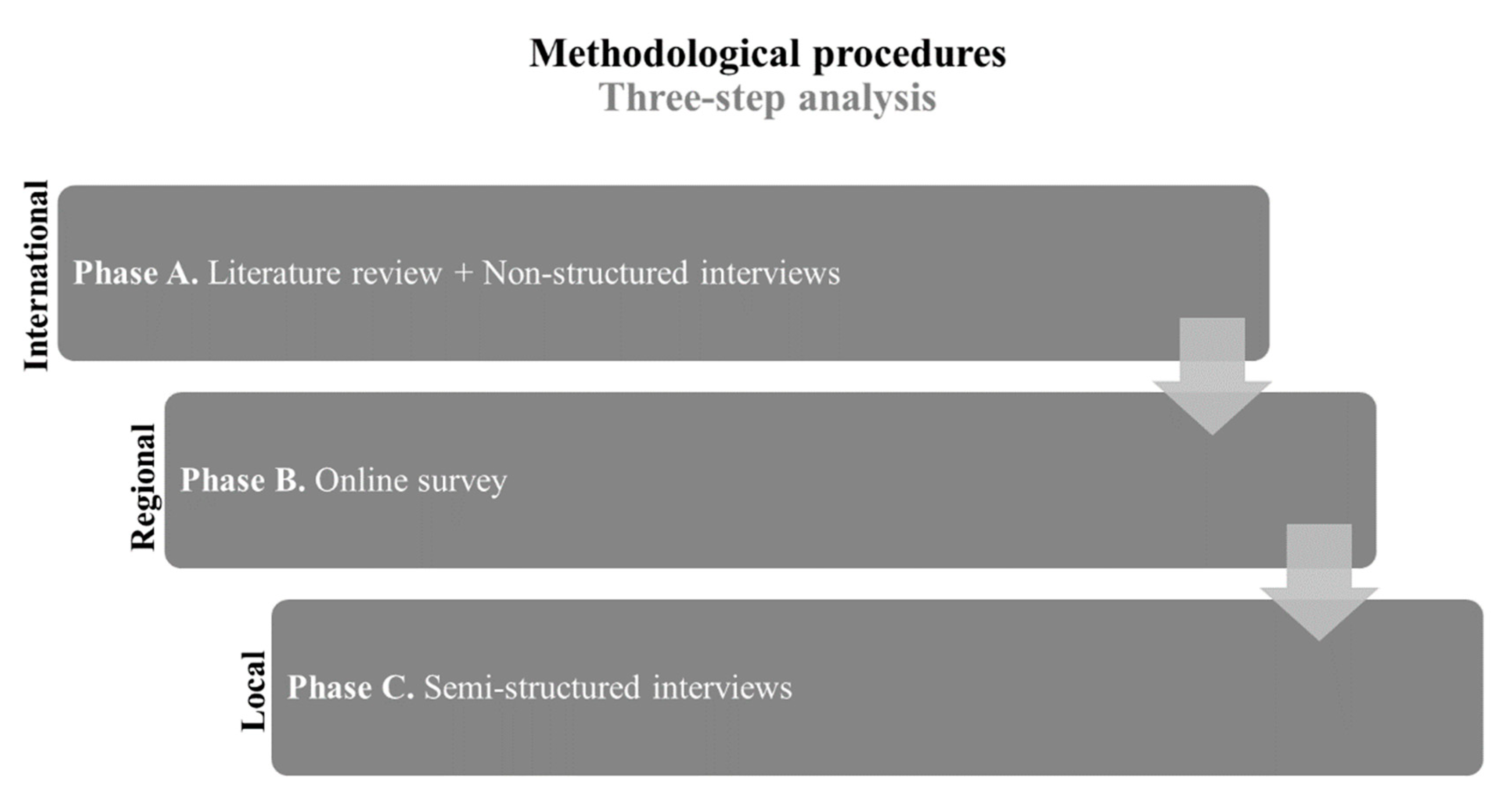

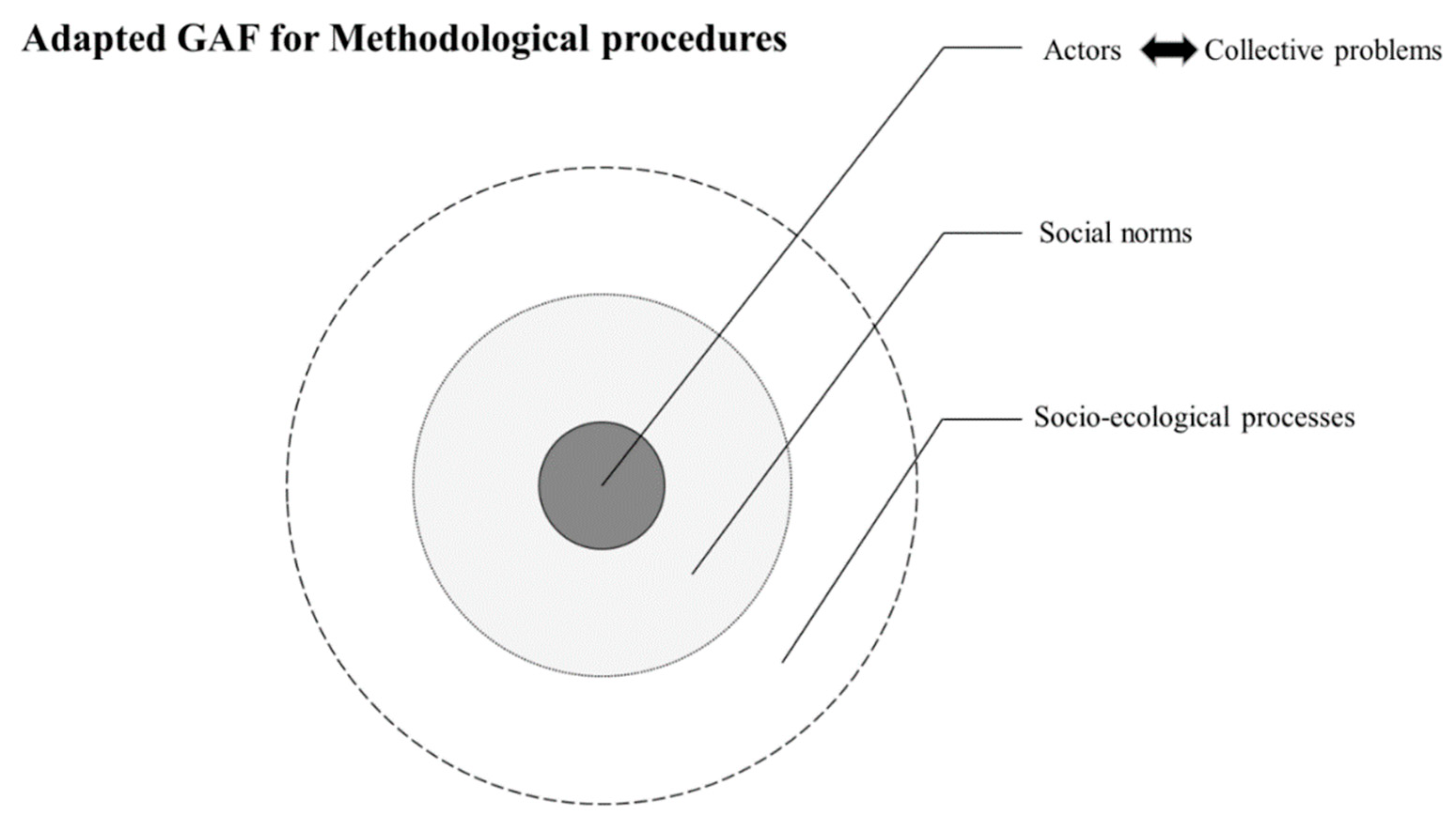
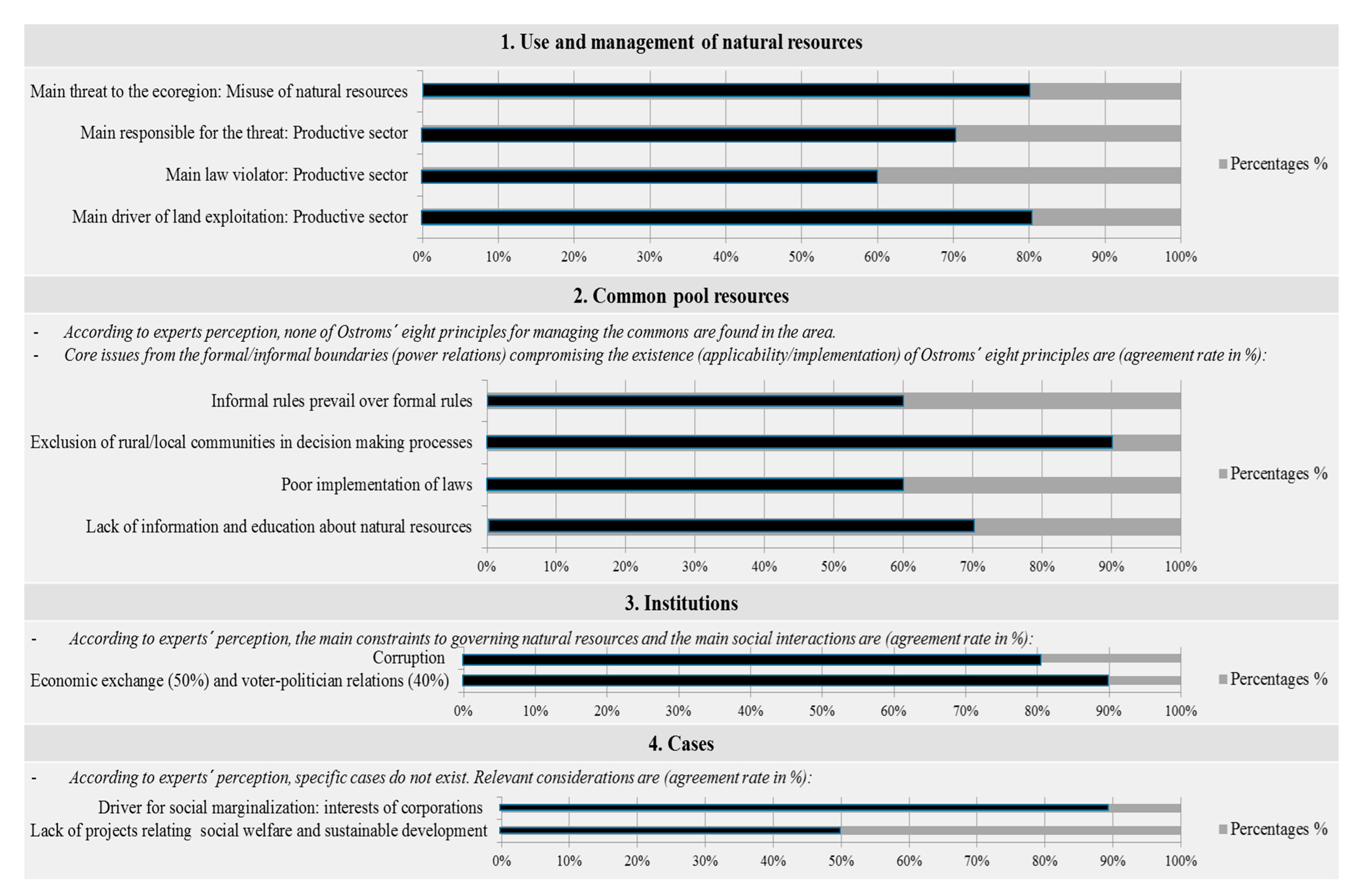
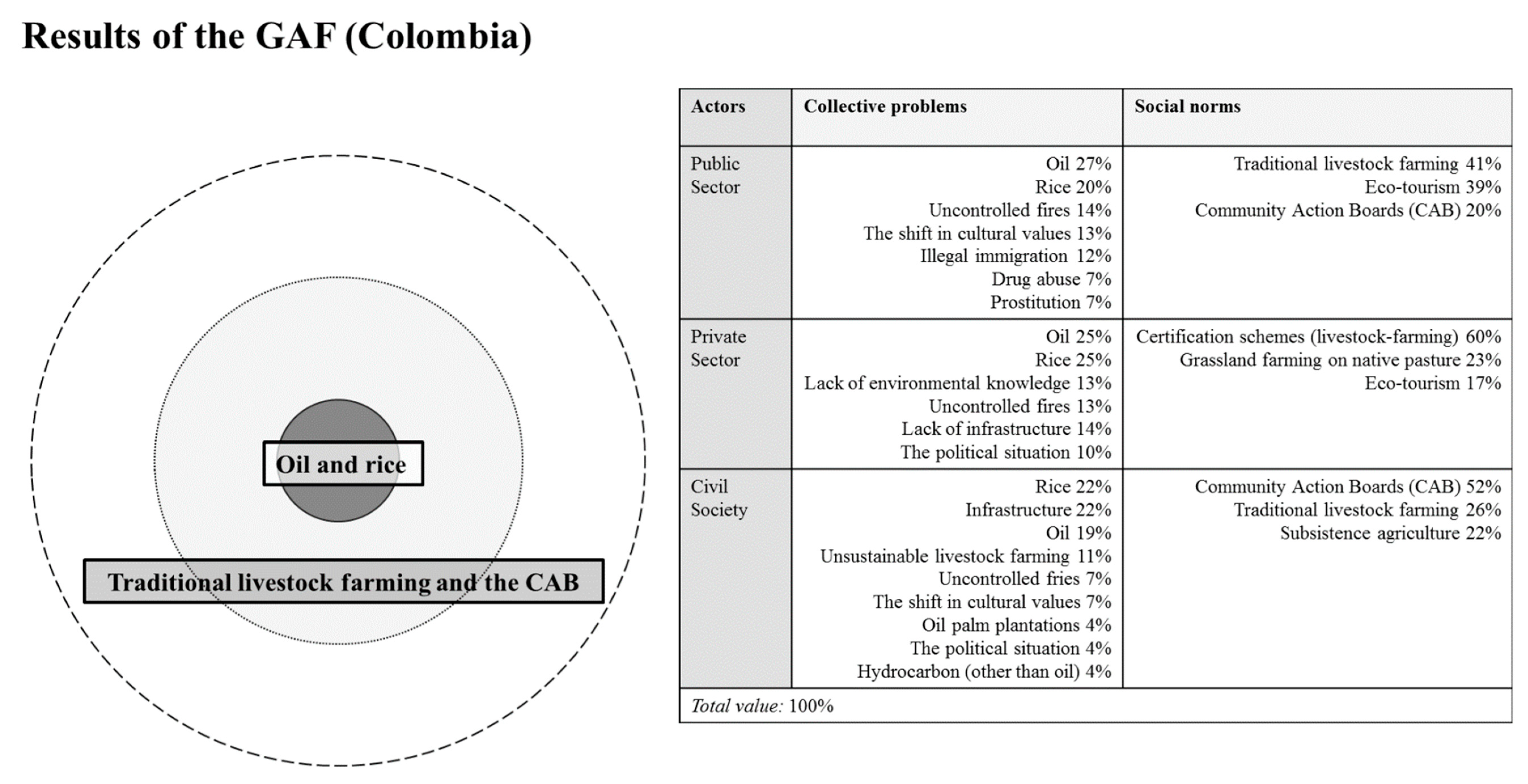

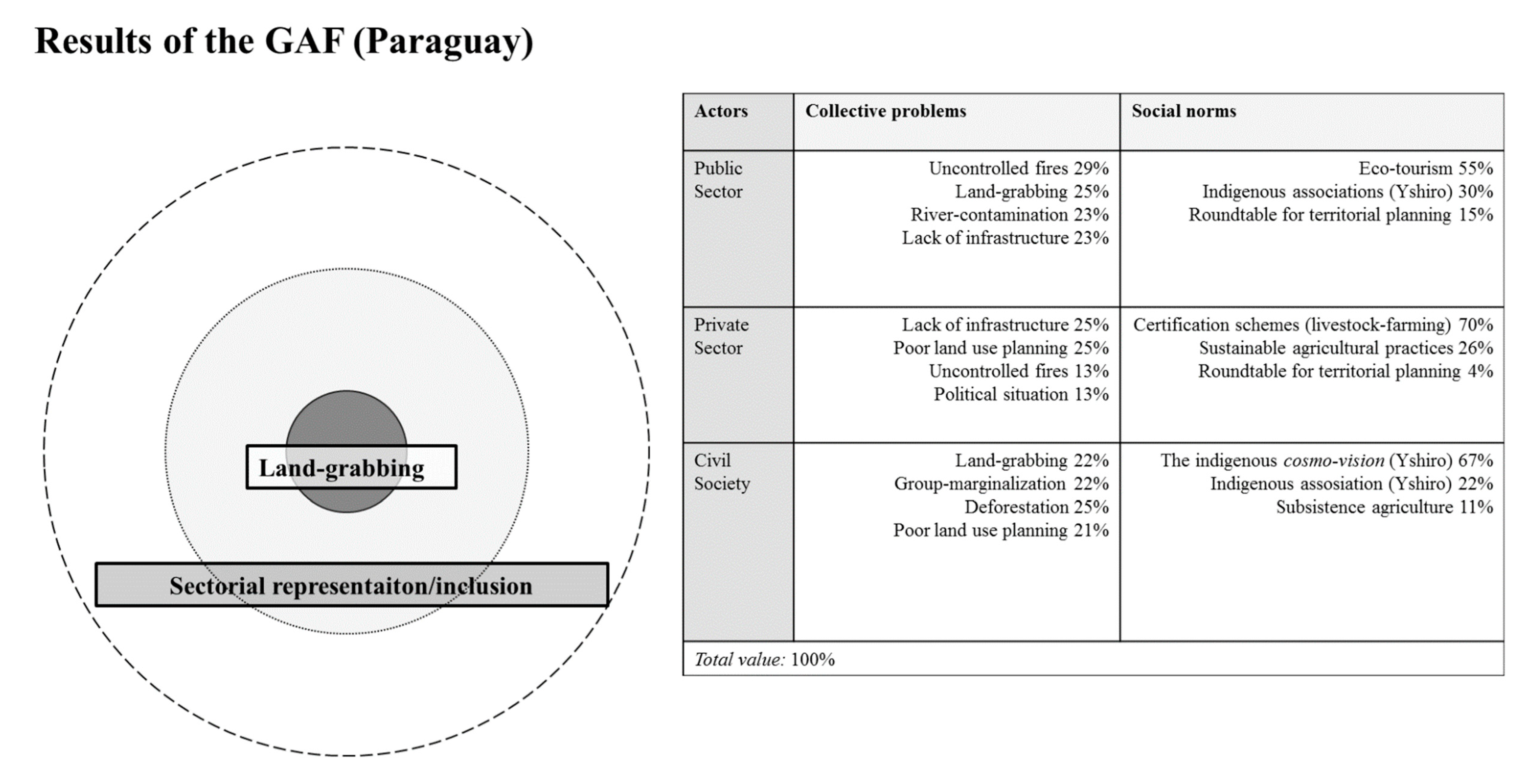
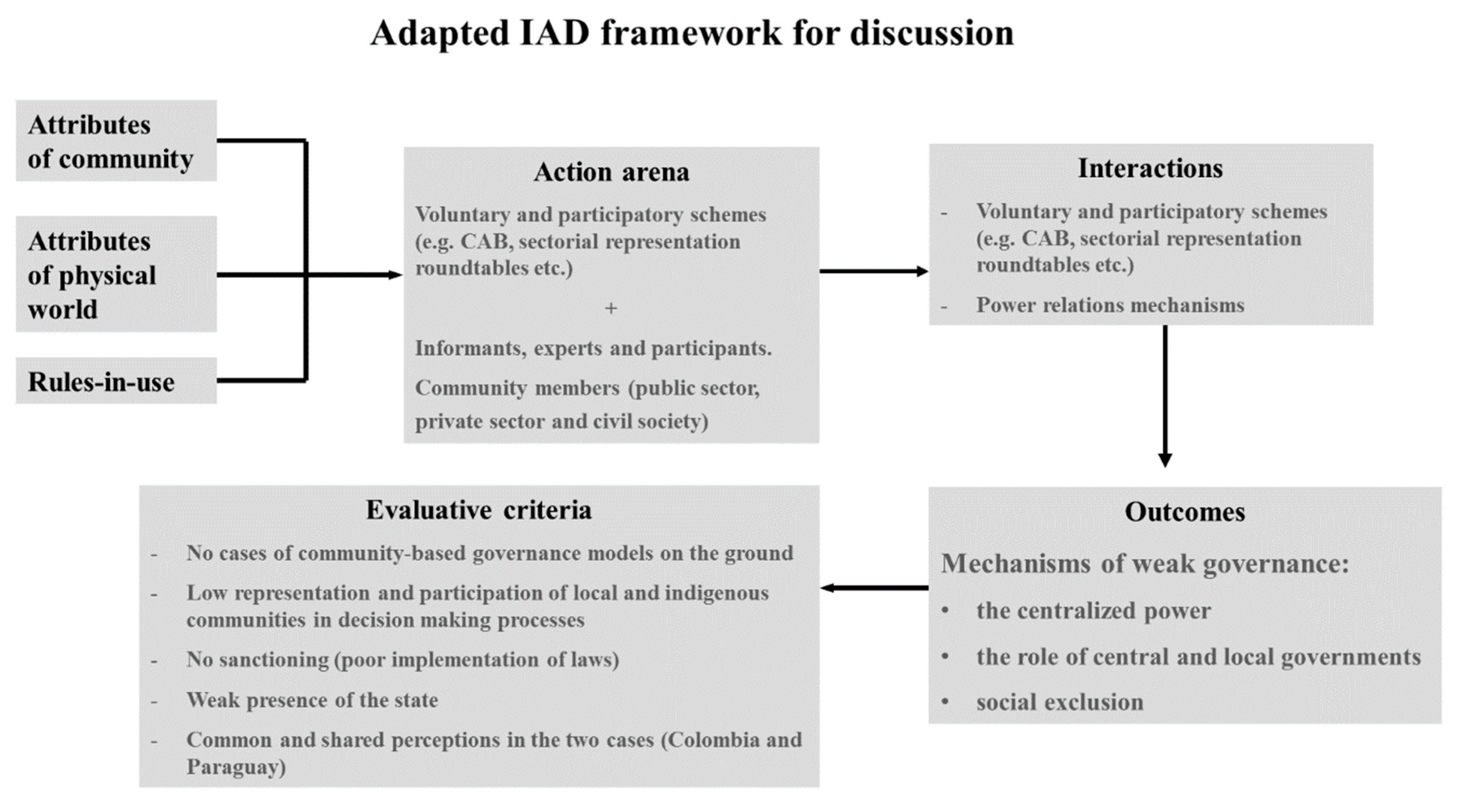
| CPR | NIE |
|---|---|
| 1. Use and management of natural resources | |
| If, and how, experts address issues about managing resources (common pool) such as grazing land, grasslands, wetlands, and forests. | Roots and significance of land distribution (property rights) according to experts’ perception (updated data from official sources is missing). |
| 2. Common pool resources | |
| If, and how, local and rural communities respond to Ostrom’s eight principles for managing Commons: | Expert’s perception of institutions and power relations in the area (hierarchy): |
| |
| |
|
|
| |
| |
|
|
| |
| |
| 3. Institutions | |
| Formal/informal/legal/illegal institutions managing natural resources. | |
| 4. Cases | |
| Specific cases of communities managing natural resources directly and in which forms. | Economic models (export-market asset) in relation to community-based rules: |
| |
| |
© 2020 by the authors. Licensee MDPI, Basel, Switzerland. This article is an open access article distributed under the terms and conditions of the Creative Commons Attribution (CC BY) license (http://creativecommons.org/licenses/by/4.0/).
Share and Cite
Eufemia, L.; Bonatti, M.; Sieber, S.; Schröter, B.; Lana, M.A. Mechanisms of Weak Governance in Grasslands and Wetlands of South America. Sustainability 2020, 12, 7214. https://doi.org/10.3390/su12177214
Eufemia L, Bonatti M, Sieber S, Schröter B, Lana MA. Mechanisms of Weak Governance in Grasslands and Wetlands of South America. Sustainability. 2020; 12(17):7214. https://doi.org/10.3390/su12177214
Chicago/Turabian StyleEufemia, Luca, Michelle Bonatti, Stefan Sieber, Barbara Schröter, and Marcos A. Lana. 2020. "Mechanisms of Weak Governance in Grasslands and Wetlands of South America" Sustainability 12, no. 17: 7214. https://doi.org/10.3390/su12177214
APA StyleEufemia, L., Bonatti, M., Sieber, S., Schröter, B., & Lana, M. A. (2020). Mechanisms of Weak Governance in Grasslands and Wetlands of South America. Sustainability, 12(17), 7214. https://doi.org/10.3390/su12177214






